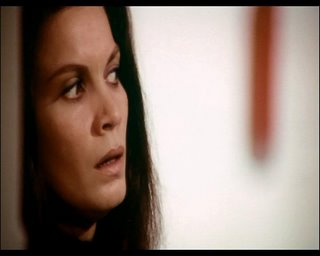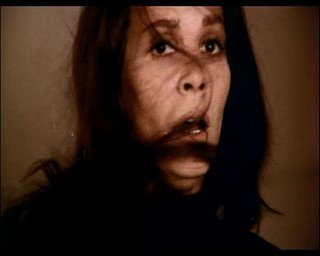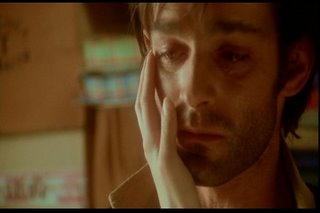Lucio Fulci
Even his fans often find Lucio Fulci's films unsatisfactory; there is usually as much to annoy as there is to please. Sometimes the most flattering reviews contain statements of exasperation or impatience; Fulci films are films for which allowances have to be made.

This is of course precisely why they are so valuable. Fulci had lost interest in go-ahead plot by the early seventies. A Lizard in a Woman's Skin (1971) is on the one hand a police procedural. It is also a study of repression and psychosis not so very different in some respects to Repulsion. But while the film contains a number of dream sequences, the most interesting scenes are those in which the madness of authority integrates itself seamlessly into the private madness of the central character. Carol Hammond is a rich young woman accused of a murder which she had seen herself committing in a dream. While recuperating in a private psychiatric clinic, Carol is chased by a young man who has been hiding in the grounds. After running up some stairs she turns into a corridor with a number of anonymous white doors. Opening one, she finds herself in a vivisection laboratory in which four dogs have been suspended from metal frames and their chests cut open to expose their hearts. They whimper and try to move - the effect is very well done, and comes as a shock to the viewer. Much effort has obviously been expended on the scene, and for what? It adds nothing to the plot - Carol faints to the ground and wakes up in her hospital bed to receive an apology from her doctor, the 'reality' of what she had seen being confirmed. The film then moves on. The viewer is left with the memory of something terrible intruding itself, minimally contextualised - suddenly the film has become more serious, but it is still in no sense a 'serious' film. Of course psychiatric authority is mad/Carol is mad/the dogs are Carol, but the scene is boldest for the way it disrupts the background setting of the 'murder mystery' and forces the viewer's attention. Fulci's scenes of violence (his 'trademark') are always gratuitous, never assimilable into the film as a whole. They are, notoriously, what the fans fast-forward to reach, and by their grotesque power they indelibly stain and highlight the boring bits around them.

Fulci's films are a patchwork, they stop and start, violence erupts out of nowhere and vanishes as quickly as it came. His films are exasperating because they refuse to be consoling. Some film makers like to claim that by showing that "violence has consequences", that "when you sock someone on the jaw, they don't just get up again", they will deny the audience their consoling illusions and force them to reflect on their own capacity for sadism. This is itself a most pernicious illusion. Nothing could be more consoling than to believe that each act of violence is followed by a moralising chain of consequences, or more flattering to the audience than to pretend that they need to be told people bleed when they're hurt. Film makers who reason in such a way are either I suspect in futile pursuit of a prophylaxis - an ultimate act of reportage which will permamently exorcise its viewers' capacity for hatred - or merely pornographers with an incidental taste for the stripped-down and raw. Violence in a Fulci film cannot end in false consolation because it is always uncontextualised - it disrupts the viewer's enjoyment, it makes no sense, it is never explained or exorcised. It cannot titillate because it is either too fantastic, too absurd for belief, or because it is so detailed and explicit that it leaves the viewer himself with no sense of private space from which he can gaze secretly and with pleasure - it is too obvious. Film violence starts to lose its dignity when gazed at for too long - the special effects give out, credibility is lost, or the audience start to find it merely tasteless.

By the time Fulci made The House by the Cemetery (1981), he was no longer interested in providing his audience with the consolations of a resolved plot or coherent motivation. Indeed, House is perhaps his most outrageous film in this respect. Ann the baby sitter has been acting suspiciously. The morning after a visiting estate agent was stabbed through the neck and dragged through the kitchen, we see Ann with a rag and bucket mopping up the blood from the floorboards. Lucy Boyle, the film's wife and mother, has now woken up and comes into the kitchen for her coffee. She makes no comment at all about the enormous blood stain, and she and Ann discuss trivia. It is a scene which many people seem to get indignant about - it is insolent. Of course it can be explained - it symbolises Lucy's capacity for self-deception with regard to the problems in her family, it is a satirical representation of somebody who refuses to see what they don't want to accept - in Lucy's case, her husband's affair with Ann, but these are merely plodding attempts at explication. The principal function of this scene is to disable the viewer's capacity for uncomplicated enjoyment.

In Fulci's 1975 western Four of the Apocalypse the scene abruptly and fantastically shifts from a scorched 'western' landscape to a snow-covered mountain village (filmed in Austria) inhabited entirely by men. Into this society comes professional card-sharp Stubby Preston, on the run from the villains with his pregnant girlfriend Bunny. Bunny is the only female in the village, and after giving birth to a boy, she dies, and the village returns to its all-male state. Stubby leaves the boy in the care of the villagers and returns to the desert. He rides alone. The ending seems set to be consolingly bleak. But as Stubby rides into the distance a little dog starts to follow him, yapping endearingly. The viewer is shocked, almost revolted. The hero has set out alone, but accompanied by a little dog! It is the film's last sudden and disrupting reversal of tone. After all the death and misery portrayed in Four of the Apocaplypse, Fulci refuses to sentimentalise or moralise. Since 'refusing to sentimentalise' is itself a form of sentimentality, the only way Fulci can do this is by introducing the figure of the little dog. The emptiness of the earlier deaths emerge retrospectively in all their bleakness. By ruining the film's expected smooth melancholy closure, everything one has had cause to be melancholy about - the victims of guns or disease - are suddenly recalled to mind, just when the logic of genre expectation would have buried them.

2 comments:
Hi Tom,
thank you very much for your 3 extremely interesting articles on Fulci (this one, Don't torture a duckling and "Lucio Fulci").
The thoughts you raise are particularly relevant and bring new angles to better understand this director's work.
In an audio interview of Fulci I heard recently (in Neo Publishing's "Beatrice Cenci" DVD bonuses), he was referring to Argento being "a craftsman who took himself for an artist". I suggest Fulci was "an artist who took himself for a craftsman".
I appreciate how Fulci disrupts traditional narrative structures in his films.
Post a Comment